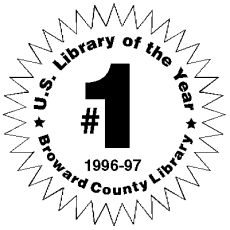Information Technology Serving the
Community

In the main library, the Community Technology Center is an important hub of the library’s effort to use electronic technology to increase its ties to the community and serve the needs of its patrons. The focus of the center is training programs and the public access terminals. Reflective of the numerous partnerships the library has with various businesses and organizations in the community, the Community Technology Center is a joint project among the library, the Broward County School Board, and SEFLIN. The center provides students and the general public with Internet, World Wide Web, and other electronic online resources, which, in the library’s opinion, will advance the library’s mission of transforming itself from collections of books to “centers for expanding knowledge.” Training of staff, teachers, and the public is seen as the key to using the technology most productively. A training group spent a year compiling a technological manual that can be used by the library’s reference staff. Other training will ensure that each branch of the library has a staff person who knows the technology and can train fellow staff in its uses.
The library administration already has a good understanding of how electronic technology is changing the behavior of users. The local Free-net has proved to be enormously popular. In fact, Free-net enrollment has turned out to be ten times the number anticipated. On the SEFLIN network, this has caused increased concern over access. Unlike library systems that rely on cable for their connectivity, the Broward County Library has limited telephone lines that cause delays at certain times of the day. In the library, staff have expressed concern that offering public access to SEFLIN from too many workstations might prevent some patrons from gaining access to the electronic catalog or other online services that the library provides.
The library staff see technology as offering useful opportunities. Conceiving of the library and its network as a people’s university, the staff believe they are giving access to people who don’t have computers at home and who otherwise would not have access to the Internet or to the growing web of electronic information. The library holds classes to teach senior citizens to use e-mail; the seniors in turn use e-mail to communicate with family members who live in other parts of the country and to gain vital information about health matters and community activities. The library tries to overcome barriers to access by providing helping aids, such as printouts of screen instructions and a few large print terminals, in the main library building to assist people with special needs.
The library also is using technology to reach out to youth. KidsCat is the children’s catalog and bibliographical service on the library’s terminals. A special program developed with the local Folke H. Peterson Charitable Foundation provides children with electronic information about animals and the environment through kiosk terminals in the main library and another branch. In an attempt to place some controls on juvenile use of the Community Technology Center, the library requires children under 18 to become registered users, sign a user agreement, and have their parents sign the agreement as well. Broward County has an unusually high population of home schoolers, and the library has made it comfortable for them to use the library and its technology. Some specially designed commercial software and learning programs also have been purchased and made available to home schoolers and their parents. The library has conducted workshops on Free-net for home schoolers and youth groups. And the library has provided curriculum support for home schoolers by communicating with them directly over the Free-net.
For teenagers, the library offers a teaching workshop called Surf the Net, which shows young people how to gain access to online information, including how to go about getting a driver’s license–something that interests most teenagers. The library also trains teens in the use of the library’s catalog (CARL) and other online resources. In turn, the teenagers volunteer to teach CARL to the public. This gives teens some concrete experience in community service and assists the library by providing public training. One regional library has a corps of more than 80 volunteer teenagers.
Technical Infrastructure
The library maintains a wide-area network using frame relay technology to connect to local area networks in the 32 facilities in the Broward County Library system. As the network hub, the library’s computer supports library workstations, two kiosks in shopping malls, a few work stations in schools for special projects, and the SEFLIN network. Branches and regional libraries connect to the main library over leased lines varying from 56K to fractional T1. The whole network will be upgraded by the end of 1996 to improve the connections from branch or regional libraries to the main library, bringing them to the level of T1, fractional T1, or T3. Users may dial in directly to the library’s catalog, but most off-site users connect to the library by dialing in to SEFLIN or using one of the two public kiosks.
Within the library system, 372 PC work stations are available for general use in public service areas, the higher level of which are 486 PCs. The library has invested in PCs with graphical capabilities for the public service areas because the library’s online catalog, CARL, has a graphical user interface. With network upgrade scheduled to begin in late 1996, the library plans to provide eight information resources at all public workstations: an encyclopedia, First Call for Help (a locally created social services resource), SIRS, electronic journal and newspapers (from multiple vendors), the text of the Fort Lauderdale Sun-Sentinel newspaper, a telephone directory, the library’s catalog, and the Internet. Twenty-five to thirty percent of the work stations are in children’s service areas. Two public computer laboratories opened in 1996, and two more are planned. The library spends ten percent or more of its collection development budget on electronic resources (leased, licensed, or purchased).

